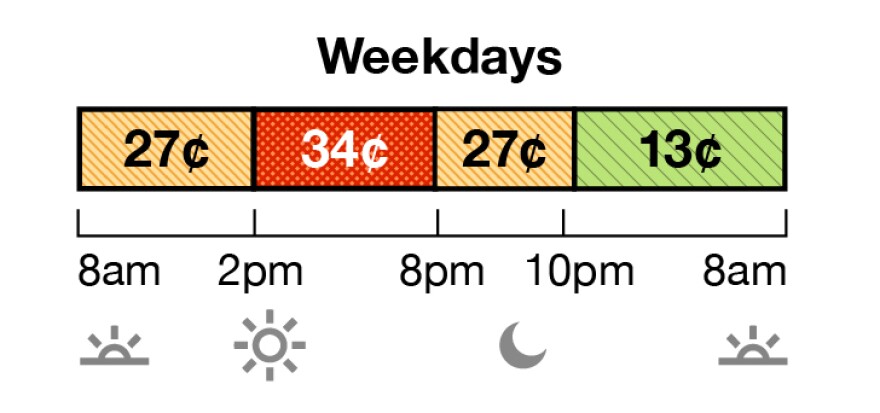Southern California Edison is rolling out new rate plans based not only on how much electricity you use, but also when you use it. KVCR's Ben Purper has the story.
Billboards across the Southland are now advertising electricity supply company Southern California Edison’s new rate plans, which include three “time-of-use” rate options that charge consumers different rates based on what time of the day they use the most electricity.
The switch to time-of-use rates comes after the California Public Utilities Commission directed the state’s major utilities companies to default their customers to time-of-use plans by 2020.
The goal behind implementing the time-of-use plans is to lessen the strain on the electrical grid during its peak hours, when use of renewable energy is at its highest. This should help the grid adjust later in the day, when it switches to more conventional sources such as natural gas.
Kari Gardner, Senior Manager of Consumer Affairs at Edison, explained that “[t]here are a variety of different of residential TUO plans that are available for our customers, so what that means is for time of use rate plans it offers different pricing during different times of day, the week, and the season. So your bill will be determined by both when you use electricity and how much you use.”
The times of the day where electricity will cost the most – known as “on-peak hours” – will be either noon to six p.m. or two to 8 p.m., depending on the plan that customers choose. That doesn’t include weekends, which are considered “off-peak” hours.
According to Gardner, “For customers who can adjust their schedules, if you will, to where perhaps during the peak periods they’re not using as much electricity, they would maybe want to consider a plan like that.”
If you’re an Edison customer, switching over to time-of-use plans is voluntary for now – but Gardner says some customers can already benefit from them.
“They could change nothing and already benefit on one of these plans or they could also make minor adjustments that might also move them to where they may benefit monetarily and from a consumption perspective under these plans.
While time-of-use plans can benefit some customers, consumer advocates warn it could raise rates for others. A recent paper co-authored by representatives from groups such as Utility Dive and the Public Interest Research Group argued that time of-use-rates “can have adverse impacts on consumers, especially on those who may have less ability to shift their usage to capture the benefits of TOU pricing.”
These plans have also been criticized for potentially devaluing solar energy, which could make it harder for the state to meet its goal of having half of its electricity come from renewable sources by 2030. The San Francisco-based Environmental Defense Fund filed a protest saying the time-of-use plans “potentially creates an economic disincentive for utilizing renewable generation capacity.”
But Gardner says that SoCal Edison is fully supportive of solar. In 2016, the company delivered more solar energy to its customers than any other utility in the nation. She also pointed out that time of use plans can offer an economic advantage to consumers with solar installations.
“Some of the benefits that we do see our solar customers experiencing is they are typically generating during the peak periods.”
It’s a benefit because customers who generate excess solar can sell it back at retail value, which is higher during on-peak times.
Gardner says that Edison customers can visit SoCal Edison’s website to use their rate comparison tool to find out how time-of-use rates could affect them.







